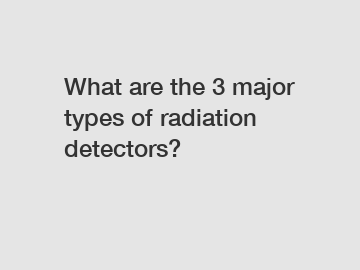Feb. 21, 2024
Machinery
Radiation detection plays a crucial role in various fields, including healthcare, nuclear power plants, and environmental monitoring. There are three major types of radiation detectors, each with its own unique capabilities and applications. Understanding the differences between these detectors is essential for ensuring accurate and reliable measurements of radiation levels. In this article, we will explore the three major types of radiation detectors and their characteristics.
### Geiger-Muller Counters.
Geiger-Muller counters, also known as Geiger counters, are one of the most widely used types of radiation detectors. These detectors work by measuring the ionizing radiation in the form of alpha, beta, gamma, and X-rays. Geiger-Muller counters consist of a gas-filled tube with a central wire electrode. When radiation enters the tube, it ionizes the gas, causing the gas to conduct electricity and create a voltage pulse that is amplified and counted by the device.

One of the key advantages of Geiger-Muller counters is their sensitivity to low levels of radiation, making them suitable for detecting small amounts of radioactive materials. These detectors are also relatively simple to operate and provide quick and easy readings of radiation levels. However, Geiger-Muller counters have limitations in terms of energy discrimination and cannot distinguish between different types of radiation.
### Scintillation Detectors.
Scintillation detectors use a different approach to detecting radiation compared to Geiger-Muller counters. These detectors contain a scintillating crystal or liquid material that emits light when exposed to ionizing radiation. The emitted light is then converted into an electrical signal, which is processed to determine the energy and type of radiation detected.
One of the main advantages of scintillation detectors is their ability to discriminate between different types of radiation based on their energy levels. This capability makes them ideal for identifying specific radioactive isotopes and monitoring radioactive contamination. Scintillation detectors are also highly precise and can measure radiation levels with high accuracy. However, these detectors are more complex and expensive than Geiger-Muller counters, requiring skilled operators for proper operation and calibration.
### Ionization Chambers.
Ionization chambers are another type of radiation detector commonly used in research laboratories, medical facilities, and industrial settings. These detectors operate by measuring the ionization of gas molecules caused by radiation, leading to the production of electric current. Ionization chambers consist of a gas-filled chamber with two electrodes, one of which is charged to create an electric field.
One of the key advantages of ionization chambers is their ability to measure a wide range of radiation levels, from very low to high doses. These detectors are also highly sensitive and can provide continuous readings of radiation levels over an extended period. However, ionization chambers are less efficient at detecting low-energy radiation compared to Geiger-Muller counters and scintillation detectors.
In conclusion, Geiger-Muller counters, scintillation detectors, and ionization chambers are the three major types of radiation detectors used in various applications. Each type of detector has its own strengths and limitations, making them suitable for different scenarios based on the specific requirements of the measurement task. Understanding the characteristics of these detectors is essential for selecting the most appropriate device for accurate and reliable radiation detection.
If you have any questions or need further information about radiation detectors, feel free to contact us.
The company is the world’s best radiation protection solutions, radiation protection solutions, introduction to radiation detectors supplier. We are your one-stop shop for all needs. Our staff are highly-specialized and will help you find the product you need.
Previous: What is the best machine to cut metal?
Next: What are the different types of PCBs based on substrate?
If you are interested in sending in a Guest Blogger Submission,welcome to write for us!
All Comments ( 0 )